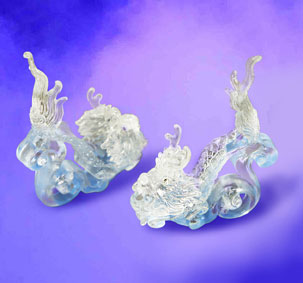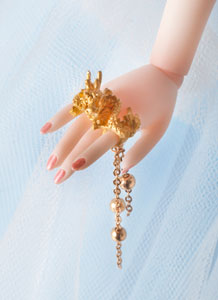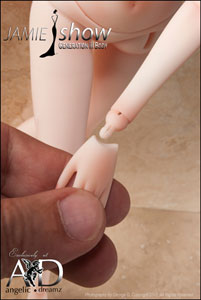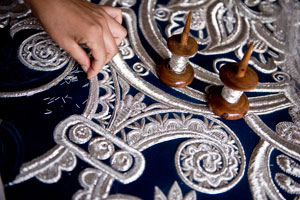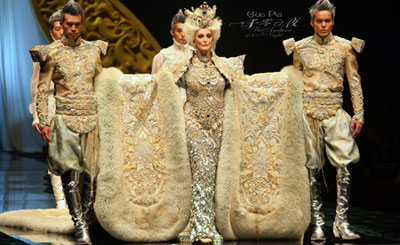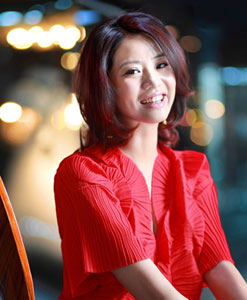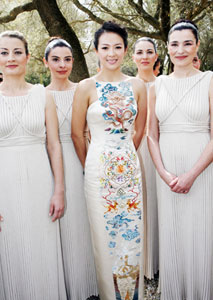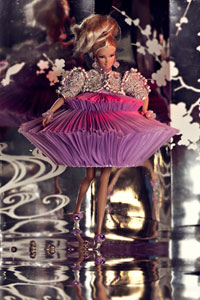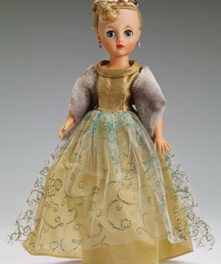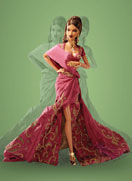“Flying Dragon, Ling Lan” was a new Haute Doll exclusive by JAMIEshow (www.jamieshowdoll.com) and Guo Pei. The dressed doll was limited to an edition of 50 and priced at $475 each, plus shipping and handling.
Guo Pei presented her “Legend of The Dragon” fashion show and “Chinese Bride Couture Exhibition” in Beijing May 6 and 7. The collection was primarily meant to showcase exquisite wedding gowns for Chinese brides – it took a team of hundreds of embroiders and seamstresses three years to make them all. One dress was embellished with 465,756 pearls and took more than 8,000 hours of hand sewing to complete.
The “Flying Dragon” doll Guo Pei designed for JAMIEshow is a doll-sized replica of a design from “Legend of the Dragon.” The doll features a new sculpt – “Ling Lan,” a model right from the runway of Guo Pei’s world. Her elaborate hairstyle is crowned with a fully beaded tiara, and her head cap is interchangeable, so she can wear any of the other wig caps offered in the JAMIEshow line. She also comes with a full-plate head cap to allow her to wear size 5 wigs. Lavish glass-drop beading frames her delicate face. Light blue eyeshadow over lovely hazel eyes and soft pink lips finish her face.
Flanked by laser-cut golden dragons, her gown is as opulent as the original, with layer upon layer of silk tulle. The bodice was hand-beaded in Guo Pei’s studio – this is the first doll dress completely handmade by her studio, and each dress will be a piece of true haute couture in every sense of the word. “Flying Dragon, Ling Lan” wears a gold dragon jewelry piece with dangling beads on her hand, and her dragon-shaped shoes are made of clear crystal.
“Ling Lan” has 19 points of articulation and is made out of opalescent J-Resin (a trademark resin owned by JAMIEshow), which is hypoallergenic and nontoxic. Her new-generation body includes new hands, which can be attached and removed simply by snapping them on and off the wrist, eliminating the need to hook the hands on the doll’s stringing. This is a unique innovation exclusive to JAMIEshow.
Guo Pei on Design, Dolls, and Dreams
Haute Doll: What did you think of designing for a doll?
Guo Pei: This is only the second time I’ve designed high-end fashions for dolls seriously. The first time was when I was invited by Mattel and Hong Kong Times Square last year to design 12 sets of doll pieces for their Barbie Christmas Party in 2011. It’s hard to describe this experience in words. At the beginning, I didn’t believe I could ever get it done. I was a high-end fashion designer, and most of my works were complicated dresses for models approximately two meters tall, wearing their high-heeled shoes.
I used to think about designing for dolls, but I never thought I would be successful. Once I started to design for dolls, I realized that it was a mission that must be accomplished. I myself felt totally astonished when the piece was gradually unfolding in front of me. Although dolls are proportionately much smaller, not a single detail was overlooked. This experience makes me feel that there is nothing that I can’t do, and it also makes me realize my true potential. It opened a door for me to design for fashion dolls in the future.
HD: How does designing in doll scale differ from human scale?
Guo Pei: The difference is significant. It is extremely difficult to convert the human model waist of approximately 60 centimeters to the doll dimension of only 6 centimeters. It’s especially hard when dealing with the differences in the dimensions of chest, waist, and hips, as well as shoulders and sleeves. Compared to those for human clothes, the sleeves of doll dresses are seldom perfect and well-shaped. However, I believe we will make breakthroughs in this challenging area in the future.
Compared to the human fashion, the doll design for “Flying Dragon” has more exaggerated proportions. This is because it is difficult to realize the degree of exaggeration in the human piece. For instance, with the skirt pannier, the width of a human dress can be as wide as 3 meters. The design effect of a doll piece can be much more perfect, because it’s difficult for human models to exhibit an extra-large profile. Designing for dolls excites me more, and it is much closer to the ideal images in my mind.
HD: Can you share some details about the design process for the piece?
Guo Pei: My inspiration for “Flying Dragon” was a Chinese traditional handcrafted candy called “Candy Pictures,” which are drawn using melted sugar. When the sugar syrup solidifies on a marble board, it can be viewed as a picture and eaten as a candy. Every year I spend my Spring Festival in Hangzhou, and there are many vendors selling this kind of candy in streets … dragon candy is the most complicated yet most popular. The dragon candy is actually an extension of bridal dresses.
The wedding-dress culture was introduced to China in the 1980s, and now it’s every young Chinese girl’s dream to wear a bridal dress on her wedding day. They usually wish to wear a bridal dress with a large train, which represents the beauty of the bride at that very moment. My work is a combination of the dream wedding dress and Chinese traditional elements.
HD: Will you design for more dolls?
Guo Pei: Yes, definitely I will. Actually, I am already on the way, and it will become one of my undertakings in the future. I hope my design work will not only be presented on real models, but also on dolls.
Making dolls has been my dream since childhood. I have collected more than 300 dolls. There is a big dream deep in my heart, which is to make fashion dolls and design dresses for dolls. Now my dream has been unfolding in front of me; it is so close I could almost touch it. Perhaps in the next six months or a year, we will create a perfect fashion-doll show. The show will review all my works, including all the pieces in the past high-end fashion shows, the dresses designed for the CCTV Spring Festival Gala as well as the Beijing 2008 Olympic Games, and the dresses I designed for Chinese stars for red-carpet events.
HD: What sort of dolls do you collect?
Guo Pei: I’ve been collecting dolls for a long time, focusing on several categories, including Barbie, Fashion Royalty, and Tonner. My daughter likes dolls with big heads, like the Blythe – these dolls all have exquisitely beautiful clothes. I learned a lot about wearing apparel through doll collecting. In the early 1980s, China just opened its door to the outside world. As a fashion designer, I needed a lot of information, but what we learned at school was far too limited. I gained a lot of inspiration from my dolls’ dresses.
As far as I know, there are very few fashion designers in the circle of doll collectors in China. I currently own the largest collection of dolls among all the fashion designers I know. I think doll collecting means a lot to my career today. I have always been fond of dolls; as a result, I can maintain a fanciful and childlike tinge in my disposition, and this has manifested in my fashion design. All those unrealistic designs I have produced came from the influence of my dolls, subconsciously. Being a child at heart makes me very happy, and this happiness renders itself in my designs.
Many people in the fashion world cannot understand why my designs are like that. In fact, those clothes are not made for other people, but for dolls. In my mind, I am playing with my dolls – only scaling their outfits up to real human size. I believe doll costumes should be fanciful. That’s why my models often find themselves moving with difficulty on the runway wearing my designs. The shoes have such high heels; the dresses flare out so much at the hem. In fact, I’m afraid they’re not exaggerated enough, as it’s too difficult to realize through a real model, but those effects will be easily achieved through my dolls.
HD: You’ve been getting a lot of attention in Western media – making “Fast Company’s” No. 6 on “The Most Creative People in Business in 2011” list and the “New York Times,” to name a few – what do you think of all this exposure?
Guo Pei: I believe beauty has no borders; people from different countries share common perceptions about beauty. The reason for those reports and attention is not about who I am, but that we have produced beautiful works. If we stick to creating beautiful things, we will draw more and more attention. People remember you by your work.
HD: What compels you to create?
Guo Pei: All creativity and designs come from the heart. J.K. Rowling, the author of the Harry Potter series, owns a wonderful inner world, and that’s why she could produce such a splendid work. She is the artist I appreciate most. Similarly, my creativity and designs also originate from my inner heart. I like to tell stories through my works – I tell mine through clothes I design, just as other artists tell theirs through music or color, and writers tell theirs through their words.
My inspirations also come from my own life experiences. As an adult, I still cherish all my childhood dreams and wishes. I like dolls as well as teddy bears. This kind of passion for life has become my creative energy. I draw more inspirations from the touching moments in life. The inspiration for my “Chinese Bride” collection came from the story of a girl who inherited her mother’s bridal gown from 50 years ago. The idea of “inheritance of happiness” is really touching. The girl might encounter difficulties in her future life, but when she thinks about the bridal gown passed down from her mother and the happy feeling when receiving it, pain and difficulties will be relieved or lifted. I decided to adapt the series to the outfits of dolls, hoping it will touch the hearts of more girls, brides, and future mothers.
HD: Is there any advice you can give aspiring designers?
Guo Pei: No matter how you define a successful life, the success comes step by step from the very beginning of life. The insights for life also accumulate little by little. I suggest young people spend more time thinking about their life. These thoughts will build up your inner world, helping you form your judgment of things, your own perspective, and your specific role in life. And these, in turn, will serve as a supportive force as you build a career, establish a happy family, and create a wonderful life.
At the ending of my show “The Legend of Dragon,” I depicted a gold dragon and a silver dragon, representing the self in an ideal world and the self in reality. As you move through reality, your wishes often get smothered, and you’ll gradually forget the ideals you had in the beginning. So the gold dragon is the symbol of one’s ideal self; the silver dragon is your self-image with its original color slowly fading out into reality. No matter what job you take, never forget you have a dream. Stop every now and then on your way to see if you have left your dream behind.
I divide my life into several 10-year periods. In the first 10 years, I was a young designer just beginning to make my own brand name. In the second 10 years, after much hardship and setbacks, I started to set up my own career. I also became a mother. Gradually I improved myself and got a clear view of who I am. Now I am more than halfway through my third 10-year period. I take it as the real beginning; it’s a fine life stage. This is the way that truly belongs to me. I believe I’ll continue to move forward in the next 10-year period – it’s the time I’m molding myself into a master.
Every young person should go through these stages. You have to know yourself. It’s harmful if you wrongly position yourself as a master in the first stage, when accumulating information and growing up. Don’t expect to succeed in the early stage; have some patience. I believe people need at least 20 years of preparation and accumulation before real success comes. Life truly begins at 40 years old, after you have passed all those stages and the gate of career opens wide for you. And there the bright road will lie in front of you.


